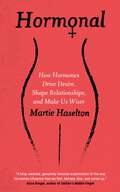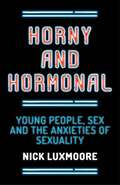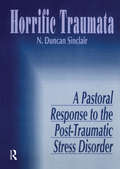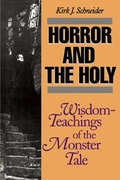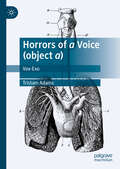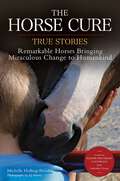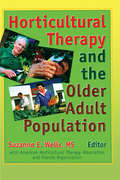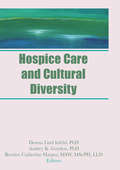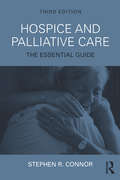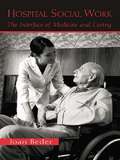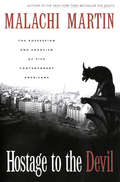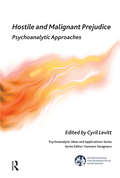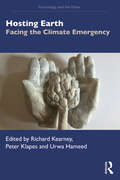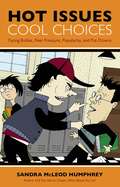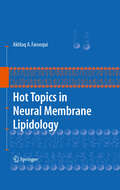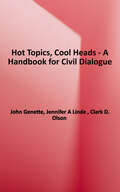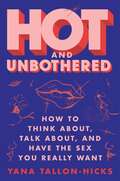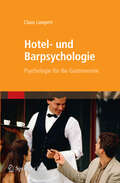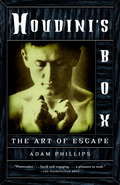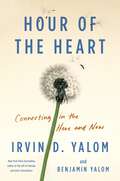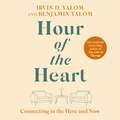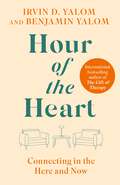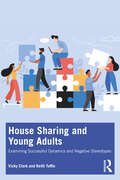- Table View
- List View
Hormonal: How Hormones Drive Desire, Shape Relationships, and Make Us Wiser
by Martie HaseltonProvocative, ground-breaking and entertaining, the world&’s leading expert on sexuality and the ovulation cycle reveals the hidden intelligence of hormones.In this paradigm-shifting book, Martie Haselton explains how hormonal intelligence works - both its strengths and its weaknesses - and shows women how to track and understand their desires, fears and perceptions with a radical new understanding of the biological processes that profoundly influence our behaviour. Rigorously researched, entertaining and empowering, Hormonal offers women deep new insights into their bodies, brains and relationships, and will encourage women everywhere to embrace the genius of female biology.
Hormones, Talent, and Career: Unlock Your Hormonal Quotient®
by Diana Derval Johan BremerThe media now regularly feature breakthroughs on the influence of prenatal hormones on the brain and behavior, for instance the link to financial performance or risk management. Based on these findings and their own experiments, the authors present the Hormonal Quotient (HQ) as a scientific, holistic and reliable career management and personal development tool for professionals. Eight HQ profiles and their corresponding typical business skills and preferences are presented and enable the reader to benchmark their HQ with peers, design an ideal career plan, build a winning team in business and find the perfect work-life balance. A complimentary website allows readers to easily measure their HQ online. By the author of "The Right Sensory Mix", Berry-AMA Book Prize Finalist 2011.
Horny and Hormonal: Young People, Sex and the Anxieties of Sexuality
by Nick LuxmooreEllis's mother is angry because he's been watching porn. Sheron says she hates her body. Mitchell's upset because Jack doesn't want to have sex with him... Sex affects everything. It may not be the single most important thing in a young person's life, but it's always important and a crucial means by which young people try to understand themselves, whether they're in sexual relationships, on the brink of sexual relationships or watching from afar. Yet sex and sexuality are subjects that many adults (including parents, counsellors, teachers and other professionals) are wary of talking about with young people. This book is about helping young people feel less anxious about sex and sexuality. It's also about helping professionals feel more confident. Weaving case material with theory and discussion, Nick Luxmoore describes vividly the dilemmas faced by so many young people and suggests ways of supporting them effectively at such a crucial and sensitive time in their lives.
Horrific Traumata: A Pastoral Response to the Post-Traumatic Stress Disorder
by William M Clements Norma J SinclairHorrific Traumata shares the stories of persons whose meaning, hope, and faith were ripped from them by others or traumatic events and who live with Post-Traumatic Stress Disorder. Since the Vietnam War, therapists have come to understand victims of severe emotional trauma with new understanding and, with better ability, have come to learn how to heal the awful effects of their traumas. Now the ranks of traumatized Vietnam veterans are joined by others who have also experienced horrific traumata and need help to rebuild their lives from Post-Traumatic Stress Disorder (PTSD)--victims and survivors of incest and rape, hostage situations, and other events outside the range of ordinary human suffering.Duncan Sinclair provides direct insight into the clinical and psychological aspects of PTSD. He presents a clear and workable understanding of the nature of PTSD which gives clergy and other involved persons direct insight into the causes of many behaviors. Horrific Traumata focuses on the church’s readiness and obligation to incorporate traumatized victims into the center of grace and healing. Clergy of all specialities now have a means of seeing behind the masks of hurt and isolation to the long-standing and disabling trauma. Sinclair shows how to promote the healing process through a range of parish activities as well as in clinical settings. Guidelines for promoting healing include the key concepts of how to listen compassionately and how to create safe places in which victims may heal during the rebuilding of hope and faith. Scriptures used throughout develop a hopefulness that must be maintained for healing. Based on the quintessential understanding that current life stressors open past wounds in ways that leave them open, Sinclair guides professionals and clergy in treating the whole traumatized person. Clergy of all specialities, pastors, chaplains, pastoral counselors, seminary students, clinical pastoral educators, and students will find healing words for hurting people in this book. Clinical specialists in all disciplines who wish to view clients’lives from a clinical and faith position will find the stories and clinical suggestions in this book to be a modern goldmine.
Horror and the Holy
by Kirk SchneiderThroughout history, human beings have been strangely fascinated by the monstrous and the macabre. In Horror and the Holy, a study of the classic horror story, Kirk Schneider explains the compelling power of such tales as a result of our thirst for the sacred, and identifies elements of the holy in familiar blood-curdling yarns. True horror arises when the mundane becomes unexpected and when the contained breaks free of its confining chains to become unlimited. Anything boundless tends to become terrifying, argues Schneider. It is infinitude, which draws us to the unsavory, infinitude that lurks behind dread. Sheer bliss, paradise, or Nirvana therefore always has the potential to turn into horror, as limits fall away and the boundless expanses of infinity open up. While ecstasy is a glimpse of the infinite, terror is full disclosure. Drawing upon a detailed and telling analysis of eleven well-known horror stories, Dr. Schneider finds that a spiritual understanding of life can be attained through horror. Classic horror steers a middle path between fanaticism and despair: the path of wonderment. Horror teaches us that human personality is paradoxical; that revulsion and disgust are the obverse of excitement and freedom, and that both poles are vital to individual, social, and ecological well-being.
Horrors of a Voice (object a): Vox-Exo
by Tristam AdamsThis book reframes the Lacanian object a voice as a horrific register of alterity. The object gaze has received, as it does in Jacques Lacan’s work, more commentary than voice. Yet recently voice has garnered interest from multiple disciplines. The book intervenes in the Slovenian school’s commentary of the ‘object voice’ in terms of two questions: audition and corporeality. This intervention synthesizes psychoanalysis with recent theorizing of the horror of philosophy. In this intervention the object a voice is argued to resonate in lacunae – epistemological voids that evoke horror in the subject. Biological and evolutionary perspectives on voice, genre horror film and literature, music videos, close readings of Freudian and Lacanian case studies and textual analysis of ancient philosophy texts all contribute to an elucidation of the horrors of the object a voice: Vox-Exo.
Horse Cure
by Michelle Holling-BrooksASHLEY was locked in closets as punishment, and physically and sexually abused, resulting in an angry and violent child who threatened her adoptive family—until she met Cocoa and Radar, the horses that helped her learn to trust again. BRENDA was diagnosed bipolar and lived through humiliating domestic abuse, but three horses—Delilah, Wiscy, and Diesel—helped her establish a sense of self-worth, hope for the future, and ultimately, the will to go on. NICK was angry, suicidal, and a veteran with combat PTSD, who now says, &“Horses literally saved my life.&” Inspired by her own childhood trauma when she spent seven days in a coma, awakened to a severely compromised body and brain, and rebuilt her life with the help of a horse, Michelle Holling-Brooks founded Unbridled Change, a non-profit Equine-Partnered Therapy organization that helps match horses to individuals in need. Here she shares amazing stories of the people she&’s worked with and the &“horse cure&” that changed their lives. Survivors of trauma, loss, illness, abuse, stress, and depression can face seemingly insurmountable obstacles. But today, a growing body of scientific evidence suggests that horses play a crucial role in therapy for those struggling with significant psychological and emotional challenges. Horses respond to angry, inhibited, heartbroken, defiant, terrified clients in many different ways, often breaking through defensive barriers via their physical presence, or by pointing to areas of psychological distress not immediately apparent. The horse&’s response guides the treatment team, as well as the client, in the healing process.
Horticultural Therapy and the Older Adult Population
by Suzanne WellsHorticultural Therapy and the Older Adult Population is the guidebook you’ve been waiting for since the American Horticultural Therapy Association’s (AHTA) 1981 publication. With an updated collection of chapters in the area of horticultural therapy and older adults--ranging from a review of relevant literature to descriptions of existing horticultural therapy programs--this book will stimulate networking and information sharing among horticultural therapists and other professionals working with older adults, spur new ideas, and foster continuing research in the field. The book’s importance is recognized internationally, and it is soon to be published in Japanese.In Horticultural Therapy and the Older Adult Population, you will find chapters on garden designs to enhance the horticultural therapy experience, descriptions of existing horticultural therapy programs for older adults, and new research to evaluate the effectiveness of horticultural therapy with this population. Whether you’re an established horticultural therapist, a nursing home administrator, or a gerontology educator, this book will help you design gardens, set up and evaluate programs, and develop curriculum.Horticultural Therapy and the Older Adult Population also includes the results of a survey sent to all registered members of AHTA who work with the older adult population. The survey responses provide information about the institutions and the population served, programming activities, program staffing, program evaluation, and funding. Another beneficial feature of the book is a resource-packed bibliography. Prepared as a service to horticultural therapists and others working with older adults, it covers the most relevant publications--giving you more places to find inspiration and ideas for improving care to the elderly through horticultural therapy.
Hospice Care and Cultural Diversity
by Donna Infeld Audrey K Gordon Bernice C HarperHospice Care and Cultural Diversity captures the richness and differences that make up the United States and its culture. This book shows you the complex issues arising from work with patients of a different culture and encourages research in hospices which support culturally innovative programs. Many people are individually knowledgeable and culturally sensitive, but few hospices have systematically planned for service to culturally diverse groups. This volume identifies who is implementing organizational programs of cultural sensitivity and acknowledges the efforts of those individuals working to make hospice accessible to everyone.Hospice Care and Cultural Diversity contains original research, personal insights, and overviews to help you understand what is being done in the field. Specifically, chapters discuss: National Hospice Organization activities, goals, and recommended actions death and dying from a Native American perspective breaking barriers to hospice for African Americans a case study of the development of a culturally sensitive treatment plan in pre-hospice south Texas caregiving norms surrounding dying and use of hospice services among Hispanic American elderly cultural considerations surrounding childhood bereavement among Cambodians in the U.S. one hospice’s experience in identifying and meeting the needs of ethnic minority patientsPeople from many different cultures are eager to share their customs, practices, and beliefs. They want hospice providers to understand their culture, and they want their community served by hospice. The only book of its kind, Hospice Care and Cultural Diversity is a valuable reference and source of ideas for anyone interested in the delivery of hospice services. From students to experts, you will find much information to help make hospice care accessible and comfortable for all groups of people.
Hospice and Palliative Care: The Essential Guide
by Stephen R. ConnorThe third edition of Hospice and Palliative Care is the essential guide to the hospice and palliative care movement both within the United States and around the world. Chapters provide mental-health and medical professionals with a comprehensive overview of the hospice practice as well as discussions of challenges and the future direction of the hospice movement. Updates to the new edition include advances in spiritual assessment and care, treatment of prolonged and complicated grief, provision of interdisciplinary palliative care in limited-resource settings, significant discussion of assisted suicide, primary healthcare including oncology, and more. Staff and volunteers new to the field along with experienced care providers and those using hospice and palliative care services will find this essential reading.
Hospital Social Work: The Interface of Medicine and Caring
by Joan BederHospital Social Work introduces the reader to the world of medicine and social work as seen through the eyes of actual social workers. An essential reference for both students and professionals. Over 100 social workers in dozens of hospitals were interviewed to provide the reader with first-hand experiences and discussions of practice principles, policy considerations, and theoretical treatments to provide each chapter with a unique blend of theory and practice. Joan Beder, a professor of social work and a practicing social worker, recently noted an apparent lack of empirical discussion of the actual role and day-to-day functioning of the medical social worker. Hospital Social Work is the result, a unique supplemental text for both studying and practicing medical social workers.
Hostage to the Devil
by Malachi MartinOne On One With SatanA chilling and highly convincing account of possession and exorcism in modern America, hailed by NBC Radio as "one of the most stirring books on the contemporary scene. "
Hostile and Malignant Prejudice: Psychoanalytic Approaches (The International Psychoanalytical Association Psychoanalytic Ideas and Applications Series)
by Cyril LevittHostile and Malignant Prejudice: Psychoanalytic Approaches represents the leading edge of work in the field by members of the International Psychoanalytical Association's Committee on Prejudice (Including Anti-Semitism), psychoanalysts who hail from Belgium, Brazil, Canada, Germany, Peru, Sweden, the United States, and Uruguay. It pursues the issues surrounding hostile and malignant prejudice as defined in the first chapter by Henri Parens, whose path-breaking work over four generations with children and their mothers uncovered the sources of aggression and prejudice on a scale from jocular slurs to murderous genocide. One chapter examines the effects of Latin America's colonial past on the psychic development of a 'mixed race' young man whose analysis implicates a major racial and social divide in the heart of his society. In another chapter we learn of the identity conflicts of children who were separated from their parents during the Holocaust and hidden or 'hidden in plain sight' by adopting a Christian persona.
Hosting Earth: Facing the Climate Emergency (Psychology and the Other)
by Richard Kearney Peter Klapes Urwa HameedHosting Earth is a timely and much-needed volume in the emerging literature of environmental philosophy, drawing upon art, science, and politics to explore alternatives to the traditional domination of nature by humans.Featuring a dialogue with Mary Robinson (former UN High Commissioner for Human Rights and former President of Ireland), which addresses the current climate emergency, this book engages the question of ecological hospitality: what does it mean to be guests of the earth as well as hosts? It includes chapters by cutting-edge scholars in the philosophy of nature, as well as artists, scientists, psychologists, and theologians. The contributors discuss proposals for a new "Poetics of the Earth," opening horizons beyond our perilous Anthropocene to a new Symbiocene of mutual collaboration between human and non-human species.Focusing on the central role that the human psyche plays in answering our current ecological emergency, Hosting Earth is for anybody invested in the future of our planet and how psychological, psychoanalytic, and philosophical thought can reorient the current conversation about ecology.
Hot Issues, Cool Choices: Facing Bullies, Peer Pressure, Popularity, And Put-downs
by Sandra McLeod HumphreyDid you know that there are kids out there who don’t even want to get out of bed in the morning because they know what going to school means for them? • being teased and taunted ... • being excluded and rejected ... • being afraid that you’re going to be assaulted and possibly hurt… • Sometimes it can even mean that you just can’t hang in there any longer, so you give up and take your own life. If you are one of the cool kids at school, this book is for you. But if you’re not one of the cool kids, this book is especially for you. Emerson Elementary isn’t a real school, but it could be your elementary school. And the students at Emerson aren’t real kids, but the problems they face are real, and so are the choices they make. The Golden Rule is an old rule, but it's still a good rule to live by, and after reading this book, you may just possibly become a kinder, more compassionate human being, someone who treats others the way you want them to treat you. So come along and join the students at Emerson Elementary and help them make some cool choices!
Hot Topics in Neural Membrane Lipidology
by Akhlaq A. FarooquiGlycerophospholipid and sphingolipid-derived lipid mediators facilitate the transfer of messages not only from one cell to another but also from one subcellular organelle to another. These molecules are not only components of neural membranes but also storage depots for lipid mediators. Information on the generation and involvement of lipid mediators in neurological disorders is scattered throughout the literature in the form of original papers and reviews. This book will provide readers with a comprehensive description of glycerophospholipid, sphingolipid and cholesterol-derived lipid mediators and their involvement in neurological disorders.
Hot Topics, Cool Heads: A Handbook for Civil Dialogue
by John Genette Jennifer A Linde Clark D. OlsonThere is a crying need for civility in our world. From families disagreeing at Thanksgiving tables to the halls of Congress, civility is in short supply. Most people can easily point to daily examples of incivility, but most people are unable to define “civility” or recognize what it looks like, much less practice it. Hot Topics, Cool Heads: A Handbook for Civil Dialogue, written by the founders of the Institute for Civil Dialogue, traces the lack of civility in our society, defines what it is from a communication perspective, then identifies the characteristics of a civil communicator and outlines the importance of civil listening. It then introduces the format of Civil Dialogue®, a method for people to present many sides of hotly contested issues. Through spontaneously participating in an audienced dialogue, participants are led through a facilitated conversation by taking a position on a provocative statement. Civil Dialogue features a semi-circle, where people who strongly agree and strongly disagree must face one another, while those who somewhat agree and somewhat disagree sit next to them, with a neutral or undecided participant completing the semi-circle. A trained facilitator opens the dialogue by asking for brief opening statements, then allowing the participants to freely discuss their thoughts and feelings while following certain “rules of civility.” The audience is then asked for comments and questions before participants give closing statements, followed by a summary of the entire dialogue by the facilitator. By modeling civility, participants learn to understand different perspectives as they give voice to their positions. These skills of a civil communicator can be used in conversations where people vehemently disagree with one another, without the goal of advocacy, but to enhance understanding. Through this understanding comes a greater foundation for democracy. Civil Dialogue can be used in a variety of contexts, so people need not fear having conversations about politics, religion, or sex. The necessary fundamentals of Civil Dialogue are included in the appendices.
Hot and Unbothered: How to Think About, Talk About, and Have the Sex You Really Want
by Yana Tallon-HicksAn acclaimed sex therapist’s practical, playful, and inclusive guide that teaches you how to discover your deepest sexual desires, communicate your wants and needs, define your boundaries, and have the sex you want.While popular culture is saturated with sex, the gap between informed sex education and satisfying sex is vast, and it often leaves LGBTQQ+ individuals out of the conversation entirely. Hot and Unbothered bridges that chasm, giving you explicit permission to talk about, think about, and achieve the pleasure you desire without shame or secrecy, no matter your sexual identity or gender.In Hot and Unbothered, Yana Tallon-Hicks provides a roadmap to empower yourself and improve your relationships, sharing the unique programs she developed for her therapy clients and workshops. She begins by shattering myths about “good sex,” which is seamless, satisfying—and nearly non-existent. Once you let go of unreachable ideals, you can start to truly identify your own unique desires and fears and build the safest space to fulfill your most pleasurable sexual experiences. Yana guides you to discover your own hang-ups and overcome barriers such as shame, secrecy, misinformation, low self-esteem, lack-of-motivation, and unhealthy relationship patterns. When the path to pleasure is cleared the fun begins! Yana helps you decide who you really are as a sexual being and how to set sexual goals. What do you want? What do you like? What have you yet to discover? And how do you want to explore? In answering these questions, you can establish and set your limits, clarify your needs, and communicate your desires to your current partner. Yana reminds you that whether your partner is a lifelong companion or a casual hook-up, your pleasure, comfort, and identity should always be supported.Yana unpacks common stumbling blocks, troubleshoots tricky conversations, and addresses potential backslides to ensure long-lasting success. Complete with worksheets and exercises, as well as playful hand-drawn illustrations, Hot and Unbothered will help you understand, pursue, and fulfill your sexual desires now, and for the rest of your life.
Hotel- und Barpsychologie
by Claus LampertHotel- und Barpsychologie, was ist denn das? Der Diplom Psychologe und Psychologische Psychotherapeut Claus Lampert stellte als Pionier auf dem Gebiet der Hotel- und Barpsychologie fest, dass sich im Gastronomie Bereich viele Mitarbeiter für psychologische Zusammenhänge interessieren. So vermittelt dieses abbildungsreiche Lehrbuch branchenrelevante fundierte psychologische Grundkenntnisse und bietet zahlreiche praktische und alltagsrelevante Übungen, die dazu anregen, die Sichtweise auf das Arbeitsfeld und sich selbst zu hinterfragen. Dieses Werk ist ein kompaktes Lehrbuch für Auszubildende, sowie ein Begleitbuch für die Fort- und Weiterbildung, wie auch eine faszinierende und spannende Lektüre für alle diejenigen, die ihre Kompetenzen und ihr Wissen in diesem Bereich erweitern wollen.
Hotel- und Barpsychologie: Psychologie für die Gastronomie
by Claus LampertHotel- und Barpsychologie, was ist denn das? Der Diplom Psychologe und Psychologische Psychotherapeut Claus Lampert stellte als Pionier auf dem Gebiet der Hotel- und Barpsychologie fest, dass sich im Gastronomie Bereich viele Mitarbeiter für psychologische Zusammenhänge interessieren. So vermittelt dieses abbildungsreiche Lehrbuch branchenrelevante fundierte psychologische Grundkenntnisse und bietet zahlreiche praktische und alltagsrelevante Übungen, die dazu anregen, die Sichtweise auf das Arbeitsfeld und sich selbst zu hinterfragen. Dieses Werk ist ein kompaktes Lehrbuch für Auszubildende, sowie ein Begleitbuch für die Fort- und Weiterbildung, wie auch eine faszinierende und spannende Lektüre für alle diejenigen, die ihre Kompetenzen und ihr Wissen in diesem Bereich erweitern wollen.
Houdini's Box
by Adam PhillipsIn this uniquely brilliant and insightful book, acclaimed essayist and psychoanalyst Adam Phillips meditates on the notion of escape in our society and in ourselves.No one can escape the desire and need to escape. By analyzing four examples of escape artists--a young girl who hides from others by closing her eyes; a grown man incapable of a relationship; Emily Dickinson, recluse extraordinaire; and Harry Houdini, the quintessential master of escape--Phillips enables readers to identify the escape artists lurking within themselves. Lucid, erudite, and audacious, Houdini's Box is another scintillating and seminal work by one of the world's most dazzlingly original thinkers.From the Trade Paperback edition.
Hour of the Heart: Connecting in the Here and Now
by Irvin D. Yalom Benjamin YalomA deeply moving and revealing chronicle of the challenges and breakthroughs that come from a wholly new practice of one-hour, one-time-only sessions, from one of the most prominent psychotherapists of our timeFacing memory loss at age ninety-three as well as the fallout from a global pandemic that moved much of daily life online, legendary psychotherapist and bestselling author Irvin D. Yalom was forced to vastly reconsider the shape of his sessions with patients. Rather than throw in the towel in the face of change, Dr. Yalom considered head-on the limitations imposed by these new realities and revolutionized his practice. Turning his focus to what might be achieved in a one-hour, one-time-only meeting between patient and practitioner, Dr. Yalom employed an even more concerted use of his “here and now” approach.In Hour of the Heart, Yalom recounts some of these intense, life-changing sessions, exploring an array of human predicaments and his own late-career development as a therapist. In recounting these consultations, he shows how a therapist’s willingness to be open helps patients let down their own guards, leading to a deeper and more immediate connection—one necessary to achieving profound realizations in just sixty minutes. This vulnerability led Yalom to disclose details about his personal life that he might previously have kept hidden from patients, including his traumatic childhood in Washington, DC, the evolution of his thinking about philosophy and psychotherapy, and the recent death of his wife. Throughout, he pushes the boundaries of self-revelation as a therapeutic tool.Life is precious and our time together short. Written in collaboration with his son, Hour of the Heart shows us how to relate to each other better in the moment, with more honesty and vulnerability. That hour of connection, occurring during a time of isolation and grief for so many, helped to sustain both patient and therapist, and enriched Yalom’s vision of what psychotherapy can do.
Hour of the Heart: Connecting in the Here and Now
by Irvin Yalom Benjamin YalomA deeply moving and revealing chronicle, from one of the most prominent psychotherapists of our time, of working under wholly new circumstances, and the challenges and breakthroughs he's made as he takes on patients for one hour, one time only.Facing memory loss at age 93, as well as the fallout from a pandemic that moved much of daily life online, legendary psychotherapist and bestselling author Irvin Yalom was forced to vastly reconsider the shape of his sessions with patients. But rather than throw in the towel in the face of change, Dr Yalom considered the limitations imposed by these new realities head on, and revolutionized his practice. Dr Yalom wondered if perhaps his own practice could focus deeply on the work that could be achieved in a one-hour, one-time meeting between patient and practitioner-employing an even more concerted use of his "here and now" approach. As he began these one-time sessions, the beloved veteran therapist found himself freed to reach ever deeper places with new patients on a shortened timeline, without the buffer of future appointments.In HOUR OF THE HEART, Yalom recounts some of these intense, life-changing consultations, exploring an array of human predicaments, and his own late-career development as a therapist. In recounting these consultations, he shows how a therapist's willingness to be open themselves helps the patient let down their own guard, leading to a deeper and more immediate connection-one necessary to achieve profound realizations in just sixty minutes.Life is precious and our time together short. HOUR OF THE HEART shows us how to relate to each other better in the moment, with more honesty and vulnerability. That hour of connection, occurring during a time of isolation and grief for so many, helped to sustain both patient and therapist, and enriched Yalom's vision of what psychotherapy can do. This transformative account of a new way of connecting and sharing is for all of us looking to build relationships with greater immediacy, authenticity, and openness-in every area of life.
Hour of the Heart: Connecting in the Here and Now
by Irvin Yalom Benjamin YalomA deeply moving and revealing chronicle, from one of the most prominent psychotherapists of our time, of working under wholly new circumstances, and the challenges and breakthroughs he's made as he takes on patients for one hour, one time only.Facing memory loss at age 93, as well as the fallout from a pandemic that moved much of daily life online, legendary psychotherapist and bestselling author Irvin Yalom was forced to vastly reconsider the shape of his sessions with patients. But rather than throw in the towel in the face of change, Dr Yalom considered the limitations imposed by these new realities head on, and revolutionized his practice. Dr Yalom wondered if perhaps his own practice could focus deeply on the work that could be achieved in a one-hour, one-time meeting between patient and practitioner-employing an even more concerted use of his "here and now" approach. As he began these one-time sessions, the beloved veteran therapist found himself freed to reach ever deeper places with new patients on a shortened timeline, without the buffer of future appointments.In HOUR OF THE HEART, Yalom recounts some of these intense, life-changing consultations, exploring an array of human predicaments, and his own late-career development as a therapist. In recounting these consultations, he shows how a therapist's willingness to be open themselves helps the patient let down their own guard, leading to a deeper and more immediate connection-one necessary to achieve profound realizations in just sixty minutes.Life is precious and our time together short. HOUR OF THE HEART shows us how to relate to each other better in the moment, with more honesty and vulnerability. That hour of connection, occurring during a time of isolation and grief for so many, helped to sustain both patient and therapist, and enriched Yalom's vision of what psychotherapy can do. This transformative account of a new way of connecting and sharing is for all of us looking to build relationships with greater immediacy, authenticity, and openness-in every area of life.
House Sharing and Young Adults: Examining successful dynamics and negative stereotypes
by Keith Tuffin Vicky ClarkHouse Sharing and Young Adults offers unique insight into the dynamics of successful house sharing among young adults and questions some of the myths fostered by the negative stereotyping of housemates. Illustrated with research from interviews with young adults, it explores co-residence, interpersonal relationships and young people’s development. Beginning with an overview of the concept and history of house sharing among young adults, Clark and Tuffin’s volume also examines the reasons for the lack of research into the area up until recently. It explores key questions, including how young adults choose housemates, what makes a desirable housemate, avoiding complications, the psychological advantages of house sharing, how conflict arises, and the impact of house sharing on adult development. The authors challenge the stigma of shared domesticity, demonstrating the potential of house sharing to enhance well-being through companionship while acknowledging the potential pitfalls caused by tension in intimate settings. House Sharing and Young Adults will be essential reading for both undergraduate and postgraduate students of social psychology, developmental psychology, sociology and anthropology, as well as those interested in group dynamics, housing demographics and discrimination.
